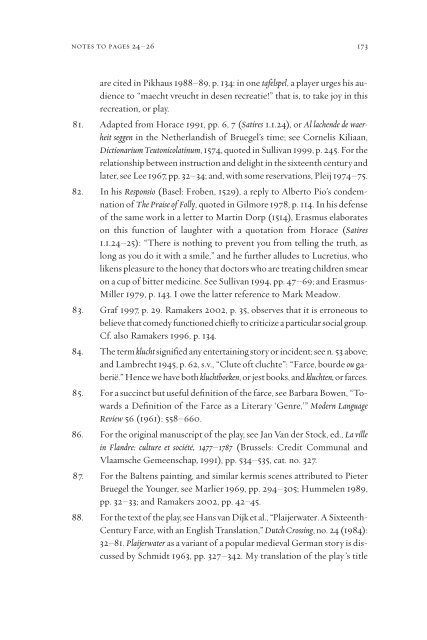Pieter Bruegel and the Art of Laughter - AAAARG.ORG
Pieter Bruegel and the Art of Laughter - AAAARG.ORG
Pieter Bruegel and the Art of Laughter - AAAARG.ORG
Create successful ePaper yourself
Turn your PDF publications into a flip-book with our unique Google optimized e-Paper software.
notes to pages 24–26 173<br />
are cited in Pikhaus 1988–89, p. 134: in one tafelspel, a player urges his audience<br />
to “maecht vreucht in desen recreatie!” that is, to take joy in this<br />
recreation, or play.<br />
81. Adapted from Horace 1991, pp. 6, 7 (Satires 1.1.24), or Al lachende de waerheit<br />
seggen in <strong>the</strong> Ne<strong>the</strong>rl<strong>and</strong>ish <strong>of</strong> <strong>Bruegel</strong>’s time; see Cornelis Kiliaan,<br />
Dictionarium Teutonicolatinum, 1574, quoted in Sullivan 1999, p. 245. For <strong>the</strong><br />
relationship between instruction <strong>and</strong> delight in <strong>the</strong> sixteenth century <strong>and</strong><br />
later, see Lee 1967, pp. 32–34; <strong>and</strong>, with some reservations, Pleij 1974–75.<br />
82. In his Responsio (Basel: Froben, 1529), a reply to Alberto Pio’s condemnation<br />
<strong>of</strong> The Praise <strong>of</strong> Folly, quoted in Gilmore 1978, p. 114. In his defense<br />
<strong>of</strong> <strong>the</strong> same work in a letter to Martin Dorp (1514), Erasmus elaborates<br />
on this function <strong>of</strong> laughter with a quotation from Horace (Satires<br />
1.1.24–25): “There is nothing to prevent you from telling <strong>the</strong> truth, as<br />
long as you do it with a smile,” <strong>and</strong> he fur<strong>the</strong>r alludes to Lucretius, who<br />
likens pleasure to <strong>the</strong> honey that doctors who are treating children smear<br />
on a cup <strong>of</strong> bitter medicine. See Sullivan 1994, pp. 47–69; <strong>and</strong> Erasmus-<br />
Miller 1979, p. 143. I owe <strong>the</strong> latter reference to Mark Meadow.<br />
83. Graf 1997, p. 29. Ramakers 2002, p. 35, observes that it is erroneous to<br />
believe that comedy functioned chiefly to criticize a particular social group.<br />
Cf. also Ramakers 1996, p. 134.<br />
84. The term klucht signified any entertaining story or incident; see n. 53 above;<br />
<strong>and</strong> Lambrecht 1945, p. 62, s.v., “Clute <strong>of</strong>t cluchte”: “Farce, bourde ou gaberië.”<br />
Hence we have both kluchtboeken, or jest books, <strong>and</strong> kluchten, or farces.<br />
85. For a succinct but useful definition <strong>of</strong> <strong>the</strong> farce, see Barbara Bowen, “Towards<br />
a Definition <strong>of</strong> <strong>the</strong> Farce as a Literary ‘Genre,’” Modern Language<br />
Review 56 (1961): 558–660.<br />
86. For <strong>the</strong> original manuscript <strong>of</strong> <strong>the</strong> play, see Jan Van der Stock, ed., La ville<br />
in Fl<strong>and</strong>re: culture et société, 1477–1787 (Brussels: Credit Communal <strong>and</strong><br />
Vlaamsche Gemeenschap, 1991), pp. 534–535, cat. no. 327.<br />
87. For <strong>the</strong> Baltens painting, <strong>and</strong> similar kermis scenes attributed to <strong>Pieter</strong><br />
<strong>Bruegel</strong> <strong>the</strong> Younger, see Marlier 1969, pp. 294–305; Hummelen 1989,<br />
pp. 32–33; <strong>and</strong> Ramakers 2002, pp. 42–45.<br />
88. For <strong>the</strong> text <strong>of</strong> <strong>the</strong> play, see Hans van Dijk et al., “Plaijerwater. A Sixteenth-<br />
Century Farce, with an English Translation,” Dutch Crossing, no. 24 (1984):<br />
32–81. Plaijerwater as a variant <strong>of</strong> a popular medieval German story is discussed<br />
by Schmidt 1963, pp. 327–342. My translation <strong>of</strong> <strong>the</strong> play ’s title












